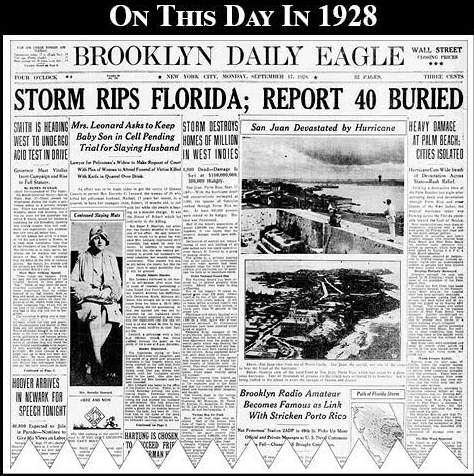September 17: ON THIS DAY in 1928, hurricane rips through Florida, Puerto Rico

ON THIS DAY IN 1928, the Brooklyn Daily Eagle reported, “Striking a destructive blow at the Palm Beaches last night after spreading death and destruction in Porto Rico and other islands of the West Indies, the tropical hurricane today was blowing across the Florida peninsula toward the Gulf of Mexico. Wire communications were down or temporarily disrupted over a wide area along the Florida east coast and in the south central portion. Reports of casualties and heavy property damage were received from Palm Beach and West Palm Beach via amateur radio operators who picked up messages which they said were signed by Station 4 A F C, a Palm Beach amateur. One message, received at Jacksonville by Gifford Grange, licensed operator, stated that an undetermined number of persons had been injured and many homes wrecked. Grange’s message, he said, was signed ‘D.H. Conkling,’ which is the name of the publisher of the Palm Beach Post. It stated the Red Cross had made a temporary hospital in the Pennsylvania Hotel because the hospital there had been partially destroyed.”
***
ON THIS DAY IN 1867, the Brooklyn Daily Eagle reported, “It has turned out that the cable dispatch, to the effect that five hundred one thousand dollars bogus American notes had been discovered in Holland, in the possession of a man named Gardersier, has only this foundation: Gardersier had in his possession notes of the amount and denomination named, issued by the Jeff Davis government. They are worth, of course, just the value of so much waste paper, whether bogus or genuine.”

Brooklyn Boro
View MoreNew York City’s most populous borough, Brooklyn, is home to nearly 2.6 million residents. If Brooklyn were an independent city it would be the fourth largest city in the United States. While Brooklyn has become the epitome of ‘cool and hip’ in recent years, for those that were born here, raised families here and improved communities over the years, Brooklyn has never been ‘uncool’.